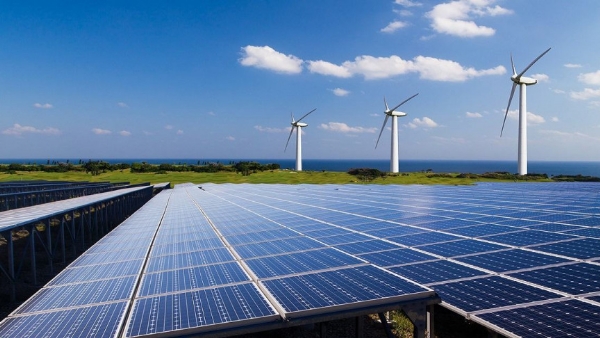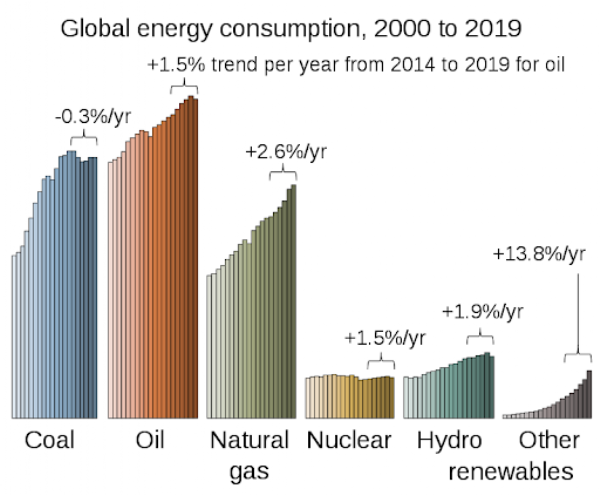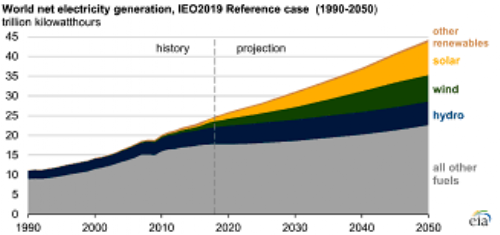Part 1 - Is India keeping abreast to meet the requirements of the New Energy Economy?
As per the IEA, India share of energy demand growth will be 25% over the next two decades - world"s third-biggest energy consumer by 2030.
Total Views |
As per International Energy Agency (IEA), the New Energy Economy is emerging prospect: shift from fossil based energy (80%) supplies today to "Renewable Energy Sources (RES) by 2050 to achieve Net Zero Emissions (NZE) by 2050. To achieve NEZ by 2050, India needs clean energy installations on land the size of Bihar, which is a misplaced utopia.

In its 2020 report, the IEA projected that by 2040 global population is expected to increase from 7.7 billion in 2019 to over 9 billion. The EIA has also released International Energy Outlook 2021 (IEO2021), which projects strong economic growth, growing populations and increasing urbanization will automatically drive increases in global energy consumption. World energy demand is skyrocketing.
India's population by 2050 is projected to increase to 185 crores from the current 135 crores. As per the IEA, India share of energy demand growth will be 25% over the next two decades - world's third-biggest energy consumer by 2030. India's energy consumption is expected to nearly double as the nation's gross domestic product (GDP) expands to an estimated $8.6 trillion by 2040. By 2050, India's projections to meet the demands is about 14,500 TWh per year (with moderate CAGR of 6.7% till 2050).
Half of world's demand is produced by China, the U.S. and the Persian Gulf States. The Gulf States and Russia export most of their production, largely to the Europe and China.

As per experts, 69% of worldwide primary production is used by end-users, 25% for conversion and transport, and 6% for non-energy products like lubricants, asphalt and petrochemicals. Today, many countries are facing a crisis of power shortages, sky-high electricity prices, and flat/rising carbon emissions. Natural gas prices are escalating. Electricity prices have tended to be highest in places with the greatest share of renewable energy.
For grid reliability in particular, natural gas- and coal-fired generating technologies as well as batteries—will remain important. Oil and natural gas production will continue to grow. By 2050, non-OECD Asia will become the largest importer of natural gas, and Russia will become the largest net exporter of natural gas. So, growth in energy consumption that will cause global energy-related carbon dioxide emissions will continue to rise through 2050. As per the IOE Report, the primary source for new electricity generation will be renewable - wind and solar energy - with electricity too cheap to meter, new energy infrastructure with little environmental impact on the land, and deep cuts in carbon emissions.

Thus, the market opportunity for clean technologies in wind turbines, solar panels, lithium-ion batteries, electrolyses and fuel cells is huge - tenfold growth to USD 1.2 trillion by 2050. These five elements alone would be larger than today’s oil industry and its associated revenues. Mobilizing large investments will be challenging. Investments needs to be six-times higher than in oil and gas supply. But the investments offers an unprecedented level of market opportunities to equipment manufacturers, service providers, developers and engineering, procurement and construction companies along the entire clean energy supply chain.
Technology innovations are on the anvil. What is the best future energy source? There are 7 energy sources of the future to include: 1. Carbon capture and sequestration; 2. Next Gen nuclear power; 3. Nuclear fusion; 4. Offshore wind; 5. Geothermal; 6. Space technologies; and 7.Solar fuels.
Is India keeping pace with energy-related innovations? Where does India stand in innovations in the field like wind, solar, hydro or geothermal? What should be the optimal mix for 2040-2050? Surprisingly, left out of consideration in the IOE Report 2021 is Nuclear Energy Power, especially its growth in India at a meager 2%. Why?
As on 31 August 2021, India's total installed power generation capacity, including from renewable energy sources is 388.134 GW as given in the Chart below:
Installed capacity by source in India as on 31 August 2021

In per capita consumption of electricity, Canada leads with 15,438 followed by the US with 13,098 KWs. India follows behind at 13th position with 968 KWs. China is at 9th position with 4,906 KWs. India's Per Capita Electricity Consumption was a mere 16.3 units in 1947, which has increased to 1208 units in 2019-20 which is quite insignificant claiming to be emerging superpower.

India energy supply as of 2021 remains largely based on coal. Of course, there has been an increasing trend in the net import of coal - steadily increased from 67.04 MTs in 2010-11 to 210.87 MTs in 2014-15. This was followed by a marginal decline in the succeeding 2 years but again started increasing though the increase in 2019-20(P).
However, India must phase out its coal-fired power plants by the middle of this century to achieve NZEs by 2050. If so, it is vital to progressively reduce coal’s share in electricity generation, currently at about 65%, and remove it altogether by 2050.
India will remain heavily dependent on import of oil - increased from 163.60 MTs during 2010-11 to 226.95 MTs during 2019-20. That reliance on overseas oil is expected to rise to 90% by 2030 and 92% by 2040, the IEA said. India's oil demand is expected to rise to 8.7 million barrels per day (bpd) in 2040 from about 5 million bpd in 2019. Rising oil demand could double India's oil import bill to about $181 billion by 2030 and nearly treble it to $255 billion by 2040 compared with 2019, the IEA said. However, India is an exporter of Petroleum Products. The current refining capacity with 23 refineries is 5 million bpd.
The export of petroleum products has increased from 59.08 MT during 2010-11 to 65.69 MT during 2019-20(P). The demand for import of oil will reach 6.4 million bpd by 2030 and 7.7 million bpd by 2040. Additional 10-12 refineries infrastructure needs to be established by 2040. Also, India will remain heavily dependent on import of gas. Natural gas used in steam turbines and gas turbines to generate electricity. And LPG (liquefied petroleum gas) used for cooking, heating and lightning. The estimated reserves of Natural Gas in the year 2020 were at 1371.89 Billion Cubic Meters (BCM). The import of Natural Gas recorded an annual growth of 17.91% from 2017 to 2018.
India is the world's fourth-largest LNG importer, which ships half of its needs in tankers currently. LNG imports are expected to quadruple to 124 billion cubic meters (BCM), or about 61% of overall gas demand by 2040. That would be up from imports of 76 BCM (about 58% of gas consumption) by 2030. It is spending billions of dollars to build infrastructure to boost use of the cleaner fuel.
Renewable energy offers opportunity to bridge the gap between demand and supply. The total potential for renewable power generation in the country as on 31.03.2020 is estimated at 1,097,465 MW. This includes solar power potential of 748990 MW (68.25%), wind power potential of 302251 MW (27.54%) at 100m hub height, SHP (small-hydro power) potential of 21134 MW (1.93%), Biomass power of 17,536 MW (1.60%), 5000 MW (0.46%) from bagasse based cogeneration in sugar mills and 2554 MW (0.23%) from waste to energy.
On 12 August 2021, India's grid-connected electricity generation capacity reached 100 GW from non-conventional renewable technologies and 46.21 GW from major hydroelectric power plants. As of 12 August 2021, there are about 50 GW projects under development and 27 GW that are tendered and yet to be auctioned. The current growth is at 12% in the previous year (2020 over 2019), that of thermal sources grew only at 1.91%. India plans to install 175 GW of renewable energy projects by 2022 and 450 GW by 2030. Renewable power can also help with production of hydrogen, which can replace more polluting fuels in hard-to-abate sectors, such as steelmaking. The focus should also be on energy efficient buildings, lighting, appliances and industrial practices to meet the net-zero goal.
However, the share of renewable in the power mix needs to climb to 90%, a more than eight-fold increase from now by 2050m that is, over 900 GWs. Much of the price of production of Photovoltaic systems is from the key component polysilicon, and most of the world supply is produced in China, especially in Xinjiang. The catch lies exactly therein.
